
Aargau, more formally the Canton of Aargau, is one of the 26 cantons forming the Swiss Confederation. It is composed of eleven districts and its capital is Aarau.

The canton of Bern, or Berne, is one of the 26 cantons forming the Swiss Confederation. Its capital city, Bern, is also the de facto capital of Switzerland. The bear is the heraldic symbol of the canton, displayed on a red-yellow background.

Lenzburg Castle is a castle located above the old part of the town of Lenzburg in the Canton of Aargau, Switzerland. It ranks among the oldest and most important of Switzerland. The castle stands on the almost circular castle hill, which rises approximately 100 m (330 ft) over the surrounding plain but is only about 250 m (820 ft) in diameter. The oldest parts of the castle date to the 11th century, when the Counts of Lenzburg built it as their seat. The castle, its historical museum and the castle hill with its Neolithic burial grounds are listed as heritage sites of national significance.

Oberflachs is a former municipality in the district of Brugg in Canton Aargau in Switzerland. It is located about 6 km south west of the town of Brugg. On 1 January 2014 the former municipalities of Oberflachs and Schinznach-Dorf merged into the new municipality of Schinznach.
The Kyburg family was a noble family of grafen (counts) in the Duchy of Swabia, a cadet line of the counts of Dillingen, who in the late 12th and early 13th centuries ruled the County of Kyburg, corresponding to much of what is now Northeastern Switzerland.

Brunegg castle is a castle in the municipality of Brunegg in the canton of Aargau in Switzerland.
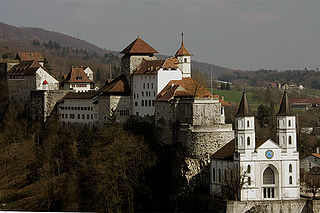
Aarburg Castle is a castle in the municipality of Aarburg in the canton of Aargau in Switzerland. It is located high above the town Aarburg on a steep, rocky hillside. The castle was built around a medieval castle, which controlled the narrow point on the Aare river and served as the seat of Aarburg Vogt. It is classified as a Swiss heritage site of national significance. Today it houses the Kantonale Jugendheim, for holding and rehabilitating juvenile offenders.

Reichenbach castle is located in Zollikofen, about 5 kilometres north of Bern. The castle was founded as a medieval fort, probably built on the site of an earlier Roman fort, on the river Aar. The medieval castle was later rebuilt in the Baroque style. It is a Swiss heritage site of national significance.
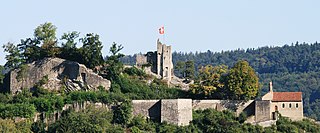
Stein Castle is a castle ruin above the municipality of Baden in the canton of Aargau in Switzerland. It is a Swiss heritage site of national significance.

Burgdorf Castle is a castle in the municipality of Burgdorf in the canton of Bern in Switzerland. It is a Swiss heritage site of national significance.

Oberhofen Castle is a castle in the municipality of Oberhofen of the Canton of Bern in Switzerland. It is a Swiss heritage site of national significance.

Spiez Castle is a castle in the municipality of Spiez of the Swiss canton of Bern. It is a Swiss heritage site of national significance.
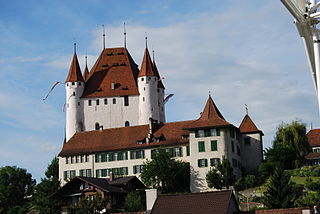
Thun Castle is a castle in the city of Thun, in the Swiss canton of Bern. It was built in the 12th century, today houses the Thun Castle museum, and is a Swiss heritage site of national significance.

Schinznach is a municipality in the district of Brugg in canton of Aargau in Switzerland. On 1 January 2014 the former municipalities of Oberflachs and Schinznach-Dorf merged to form the new municipality of Schinznach.
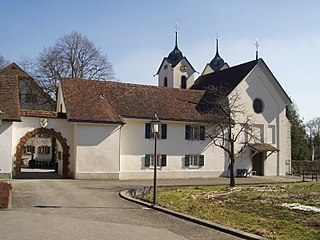
Böttstein Castle is a castle in the municipality of Böttstein in the canton of Aargau in Switzerland.

Liebegg Castle is a small castle in the municipality of Gränichen in the canton of Aargau in Switzerland. It is located on a outcropping about 70 meters (230 ft) above the Wynental valley floor. The current castle grew out of a medieval castle. A cantonal agricultural school opened in 1958 near the castle.

Trostburg Castle is a small castle in the municipality of Teufenthal in the canton of Aargau in Switzerland.
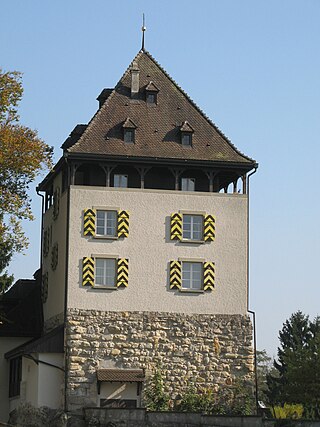
Auenstein Castle is a castle in the municipality of Auenstein in the Swiss canton of Aargau.
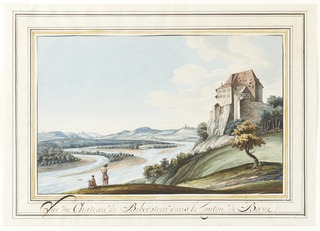
Biberstein Castle is a castle in the municipality of Biberstein in the Swiss canton of Aargau.

Muri Castle is a castle in the municipality of Muri in the canton of Bern in Switzerland.





















